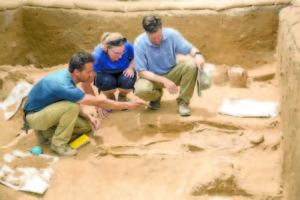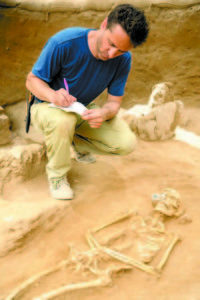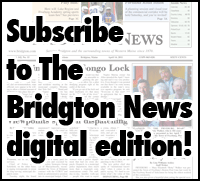One on One with…Adam Aja, museum curator and senior staff member of Ashkelon dig

WORKING A DIG SITE in Ashkelon, Israel is senior staff Adam Aja (left, a Lake Region graduate and former Bridgton resident), Sherry Fox and Daniel Master discuss a 10th-9th century BC burial in the excavation of the Philistine cemetery by the Leon Levy Expedition to Ashkelon. (Photo by Tsafrir Abayov)
By Wayne E. Rivet
Staff Writer
Adam Aja knows what it is like to find a needle in a haystack, sort of.
Working several summers in Israel as an Assistant Director of Field Operations at Ashkelon, the former Bridgton resident made a startling find at the end of one dig period.
Through the help of a co-worker using an excavator, Aja uncovered a Philistine cemetery, the first major burial site discovered in the area, ever. Further excavation over the next year resulted in unearthing 200 fully-articulated skeletons laid out in burial positions, as well as some weapons.
In an i24 television interview, Adam talked about the moment of discovery. The crew was approached by a surveyor, who had found some human remains. He wondered why no one had continued work there.
“So we investigated his story, but couldn’t find any reports. But, we found he was who he claimed to be. So, we checked the area where he claimed to have found them (remains). They were 60 centimeters below the topsoil. It’s not much. We went out and did trench after trench after trench, but found absolutely nothing,†Adam said. “We went deeper. It was a lost cause. I spoke with the project’s director, and he felt it was worth one more try.â€
Not wanting to invest too much money on a potential wild goose chase, Adam and a backhoe operator tried a few other locations. Again, nothing. Just empty soil.
“On the sixth try, I found some Roman jars on top of a sand layer. I called the director about the discovery, but he told me it wasn’t what we were looking for and get out of the holes because it was very dangerous,†Adam said. “The backhoe operator had lowered me down in a bucket into the bottom of the trench. I had one more trench left, about 45 minutes left in the day. I felt this was the last chance. He scooped into the sand, I examined dirt and found bones in it. I climbed back into his bucket, scraped around some more, and found additional bones, including a human tooth. That’s when I knew.â€
A two-day exploration followed. Initially, the crew found nothing, but then suddenly, they uncovered remains.
“It was a crazy two days,†he added. “We just kept finding body after body.â€

ADAM AJA examines skeletal remains discovered during the Ashkelon excavation. (Photo by Tsafrir Abayov)
A few weeks ago, Aja and his family (wife Melissa is an official dig photographer, while daughter, Ellie, not yet three years old, supervises) returned from Israel after a six- to eight-week excursion and The News went one-on-one with current assistant curator in charge of Collections at Harvard’s Semitic Museum.
Bio: Adam Aja grew up in Bridgton, the son of Linda Whiting. He graduated from Lake Region High School in 1988. While at Lake Region High, he was heavily involved with the cross-country running team, as well as the theater and music programs.
“I had enjoyed science classes and went to Clark University (Worcester, Mass.) to study biochemistry, but later switched to pursue Ancient Civilizations,†he said. “After graduating with my BA, I returned to Maine to teach for several years. I worked for Sweetser Children’s Services in Saco and Windham before coming to teach Social Studies and History at the Learning Center in Casco.â€
While he taught during the school year, Adam spent each summer working on different archaeological projects in Israel. He started doing archaeological excavation while still an undergraduate at Clark University and had maintained his professional contacts in the subsequent years. He left Maine to attend graduate school at Harvard University, earning his PhD in 2009 in Near Eastern Languages and Civilizations, with a specialization in Archaeology. I
Adam worked on various projects in London, Israel and Turkey. He has been the Assistant Director on the Leon Levy Expedition to Ashkelon since 2010, and the Grid Supervisor of the Philistine Cemetery excavation area since discovering it in 2013.
BN. How did you become interested in archaeology?
Adam: While I originally intended to study biochemistry at Clark University, I soon realized that I was not cut out for lab work. Much to my surprise, after taking a class to fulfill a requirement, I discovered that I enjoyed studying and reading about mythology and history far more. Another course in archaeology sparked my interest and I sought out an opportunity to try field excavation as soon as possible. It seemed like the perfect blend of physical outdoor activity and stimulating mental challenges, coupled with the excitement of discovery.
BN. What expeditions did you take part in (prior to Ashkelon), and what was most memorable?
Adam: I got my first field training in London, England. I worked there for four continuous months on various excavations, mostly “rescue†projects around construction sites. Although there were no great discoveries during that time, and little money, it was when I truly fell in love with archaeology. It was dirty, hard work, but I couldn’t get enough of it. Since I had studied classical civilization, I planned to become a classical archaeologist. A faculty member that I was studying with recommended that I work on a summer excavation project in Israel, where she had received her training. It was not a dig focused upon Classical Archaeology, but I knew that the Romans had controlled the Eastern Mediterranean. I figured that I could specialize in that area of the world and make some contacts while at the dig.
Those six weeks at the Tel Miqne-Ekron excavation changed my life. It turned my attention to the study of the Bronze and Iron Age peoples of the Eastern Mediterranean. I returned to work on the project for five years and following the close of the excavation in 1996, I began at the Leon Levy Expedition to Ashkelon, Israel. It too closed for a period between 2000 and 2007. In that window of time, I began working in Turkey, most notably with the excavation team of Tel Tayinat.
It is hard to select the “most memorable†expedition — my career has been variously shaped by each one. Obviously, my most recent discoveries in Ashkelon are notable, but unique experiences from each project will live with me forever. I have seen artifacts that I excavated in museum displays, and I appreciate the opportunity to contribute to the knowledge of ancient history. It is not just the archaeological discoveries that are memorable, but also the people you work with and the places you visit. I’ve made lifelong friends and witnessed incredible things along the way.
BN. When you are working a site, what attributes are essential, what is the most difficult aspect about this type of work, and what is most rewarding?
Adam: The ability to maintain focus and pay attention to detail is critical to success. It becomes particularly difficult after long hours in the hot sun. This is dirty, sweaty work, but it is not mindless digging. A good archaeologist must detect slight differences in soil composition, color, and compaction (among other things) and diagnose how best to proceed in order to properly excavate. It is said that one difference between a bad archaeologist and a good archaeologist is that a good archaeologist knows when to dig slow, but more importantly, when it is appropriate to dig fast. We have limited time available to us to excavate a site. We want to capture the most data in the time allotted. If we go too slowly, we may miss out on important information or discovery that is just a little bit lower. I find that one of the most rewarding aspects comes after we have excavated a particularly challenging area. If it was done correctly, we find that it “fits†with our expectations and we can add to the picture of the past that we are discovering.
BN. I saw the interview you conducted on i24 News (http://www.i24news.tv/en/tv/replay/the-daily-beat/x4jyy0h#/the-daily-beat/x4jyy0h — at about the eight minute mark of the program), which you explained the find in Ashkelon. What did it mean to you personally and professionally?
Adam: It has been a privilege to be part of such a major discovery, and very rewarding to have been involved from the beginning. I expect the results stemming from this work to be one of the major contributions to archaeology in the region. That is one of the things I think all archaeologists and historians hope for, to make a contribution to world knowledge.
BN. Regarding the find, how important was it, what will be learned, what fascinated you the most about it?
Adam: While the Philistines are perhaps best known as the villains of the Hebrew Bible, we can now illustrate details of their culture that are not discussed in that text, or in other extra-biblical notes. Over the past 100 years or so, archaeologists have developed a very interesting picture of the Philistines based upon the limited evidence available to us from excavation. I have written a bit on architectural differences from the Israelites, but we know that they also had a slightly different diet (they ate pig and dog), pottery styles, and cult paraphernalia, among other things. These were not rude, uncultured barbarians. On the contrary, they were sophisticated urban people. Philistines were masters of trade, managing complex and intricate networks around the Mediterranean, up and down the coast, and overland.
The discovery of the cemetery allows us to add more to the ever-growing story of the Philistines. Now, instead of just relying upon the texts of their enemies, or upon archaeological scraps from their cities, we have now come “face-to-face†with the people. The importance of this work was not lost on the excavation team. For me, I was particularly moved by seeing the jewelry upon the bodies of these people. I have found single beads in excavations before, but to see how the beads were strung and where they were worn was something entirely new.
BN. How long has work being going on there, explain what happens to the human remains and other items that are found, and how long will work continue at the site?
Adam: The Leon Levy Expedition to Ashkelon started under the direction of Lawrence Stager in 1985, but there were a few earlier expeditions on the ancient mound in the late 18th and early 19th centuries. The work since 1985 was primarily supported by the benefactors Leon Levy and his wife, Shelby White. Stager took on a Co-Director, Daniel Master, when the project renewed in 2007 after a hiatus. With the close of this 2016 season, the Leon Levy Expedition is officially closed and I don’t expect any large-scale scientific excavation to continue on the site for several decades. The site is simply too large and complex. The main projects going forward will be the restoration of some ancient structures for tourism and the publication of the previous 30 years of archaeological excavation. All artifacts remain the property of Israel, and will be turned over to the Israel Antiquities Authority following publication. Some may appear in future museum exhibitions. Some are already on display.
BN. What work lies ahead for you (in regards to this specific find)? What research was involved prior to taking part in this expedition?
Adam: The senior members of the staff will be presenting the preliminary results from the cemetery project at a professional conference this fall. I will be writing a summary article for publication before the end of the year in a formal, peer-reviewed journal. There may be some additional popular articles as well, for the general public. Interest has been, not unexpectedly, high. The research team will conduct scientific tests on the material, and artifacts will be photographed and drawn. This work started in 2013 and will continue through the publication of a comprehensive book detailing all aspects of the Philistine Cemetery project.
BN. As assistant curator in charge of Collections at Harvard’s Semitic Museum, what are your responsibilities, how long have you held this position, and what do you enjoy most about it?
Adam: The Semitic Museum, founded in 1889, curates over 40,000 Near Eastern artifacts excavated from regions of the Semitic-speaking world, most notably Egypt, Iraq, Israel, Jordan, Syria, and Tunisia. We use the collection in teaching, research, and exhibition. Since it is a small museum, I have a wide variety of duties pertaining to the organization, care, and access to the collection. We host scholars from all over the world who are conducting research into the collection. I started in 2009. Since I have always been a bit of a “jack-of-all-trades,†I enjoy the myriad tasks that can range from packing artifacts for a loan to writing text for exhibition. I have a great deal of freedom to try new things and pursue my interests.
BN. Any future goals/objectives you have in mind?
Adam: I plan to continue with field archaeology while pursuing the Philistine Cemetery publication. Most of the Ashkelon team will return next summer to work together at the site of Tel Shimron in the Jezreel Valley. This is a major new project with a multiyear research plan. I will serve as the Chief Stratigrapher. We will accept volunteers to work at the site, everyone from retirees seeking adventure through college students exploring career opportunities. I encourage anyone interested in exploring archaeology first hand to check out our new website: http://www.telshimronexcavations.com/.
BN. Sometimes students living in rural communities, such as towns in the Lake Region, don’t think big in terms of future careers. What would you tell them or words of encouragement given regarding pursuit of a dream or a certain professional path?
Adam: You don’t have to have it all figured out right now. Just keep moving forward toward something that you want. Start with figuring out what you enjoy and then just ask questions. Recognize that you don’t and can’t know it all at the start. So much develops as you learn more and educate yourselves about possibilities. The people you meet along the way will be critical. Talk to them and take advantage of their experience and knowledge.

